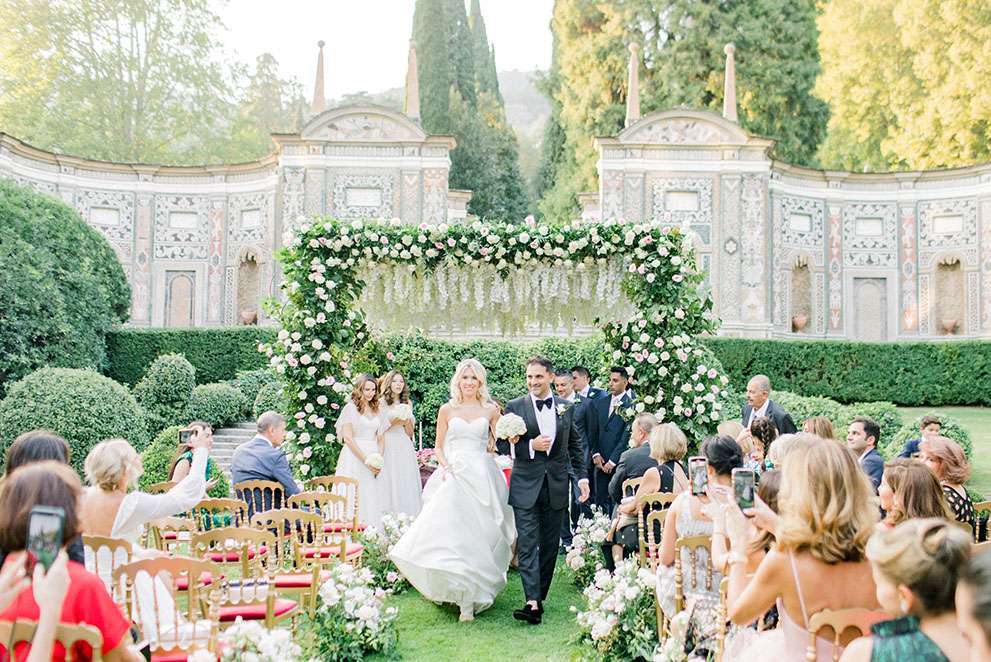
One of the perks of being a wedding planner is that I can meet brides and grooms from all over the world who share many different cultures, each one more interesting than the other. Getting to know the wedding traditions of their mother culture allows me not only to organise a tailor-made wedding for the bride and groom, but also to create a truly original event, in which their cultures and the Italian territory come together with wonderful results.
Iranian or Persian weddings are some of the events that I organise most enthusiastically, perhaps because with their traditional rites they are able to transport those present to another dimension, one that is distant in time but at the same time vivid and full of splendour, thanks to the respect for ancient traditions that seem to hark back to mythical times; it is no coincidence that the Persian ceremonies I have organised are also some of the most sumptuous. Elina and Sam, with their destination wedding on Lake Como, are the perfect example.
In Persian culture, weddings are not to be celebrated quietly and discreetly but, on the contrary, they need to be joyful and lavish, which is why Elina and Sam chose to get married in the gardens of one of the most luxurious villas on Lake Como, Villa d’Este. With its elegant structure that conveys its majesty at first glance, its large and beautifully designed spaces and its access from the lake, it was the perfect location for such a sumptuous wedding.
Organising a Persian wedding is anything but simple, but it is the attention that tradition pays to the single detail that makes it truly impressive. Today I want to talk about the most important rite, the decisive one: the wedding banquet, called Sofreh-ye Aghd.
Traditionally, couples pronounce their vows seated at a low table with a strong symbolic value: no one but the bride and groom and their loved ones may touch it, not even the wedding planner, who must leave it to the people in charge to bring the precious tablecloth and richly set the table. On the table, the objects that stand out above all others are the mirror and the candelabra, representing light and fire each, two elements of great symbolic value. Other objects, some of which arrived directly from Iran, include a tray of spices, representing abundance; hard-boiled eggs, symbolising fertility; crystallised sugar cones, invoking a sweet life for the bride and groom; decorated bread, the Koran and so on. Particularly moving is the moment when the bride and groom promise each other a conjugal future full of sweet words by covering each other’s lips with honey.
After the ceremony, their families may finally join the banquet. Elina, Sam and their loved ones moved into the villa which, with its extremely elegant and sumptuous style, provided the ideal visual backdrop for their reception, but that was not all. At a Persian wedding, the celebrations last a long time and often involve several locations: the couple, for example, decided to continue celebrating at a second, equally luxurious villa on Lake Como – Villa Geno. A marquee was set up in the gardens and guests danced until late into the night, bringing to a close one of the most beautiful weddings I have ever had the pleasure of organising.
Iranian or Persian weddings are some of the events that I organise most enthusiastically, perhaps because with their traditional rites they are able to transport those present to another dimension, one that is distant in time but at the same time vivid and full of splendour, thanks to the respect for ancient traditions that seem to hark back to mythical times; it is no coincidence that the Persian ceremonies I have organised are also some of the most sumptuous. Elina and Sam, with their destination wedding on Lake Como, are the perfect example.
In Persian culture, weddings are not to be celebrated quietly and discreetly but, on the contrary, they need to be joyful and lavish, which is why Elina and Sam chose to get married in the gardens of one of the most luxurious villas on Lake Como, Villa d’Este. With its elegant structure that conveys its majesty at first glance, its large and beautifully designed spaces and its access from the lake, it was the perfect location for such a sumptuous wedding.
Organising a Persian wedding is anything but simple, but it is the attention that tradition pays to the single detail that makes it truly impressive. Today I want to talk about the most important rite, the decisive one: the wedding banquet, called Sofreh-ye Aghd.
Traditionally, couples pronounce their vows seated at a low table with a strong symbolic value: no one but the bride and groom and their loved ones may touch it, not even the wedding planner, who must leave it to the people in charge to bring the precious tablecloth and richly set the table. On the table, the objects that stand out above all others are the mirror and the candelabra, representing light and fire each, two elements of great symbolic value. Other objects, some of which arrived directly from Iran, include a tray of spices, representing abundance; hard-boiled eggs, symbolising fertility; crystallised sugar cones, invoking a sweet life for the bride and groom; decorated bread, the Koran and so on. Particularly moving is the moment when the bride and groom promise each other a conjugal future full of sweet words by covering each other’s lips with honey.
After the ceremony, their families may finally join the banquet. Elina, Sam and their loved ones moved into the villa which, with its extremely elegant and sumptuous style, provided the ideal visual backdrop for their reception, but that was not all. At a Persian wedding, the celebrations last a long time and often involve several locations: the couple, for example, decided to continue celebrating at a second, equally luxurious villa on Lake Como – Villa Geno. A marquee was set up in the gardens and guests danced until late into the night, bringing to a close one of the most beautiful weddings I have ever had the pleasure of organising.
2025 © - P.IVA 03035100969 - Design by webvox.it



